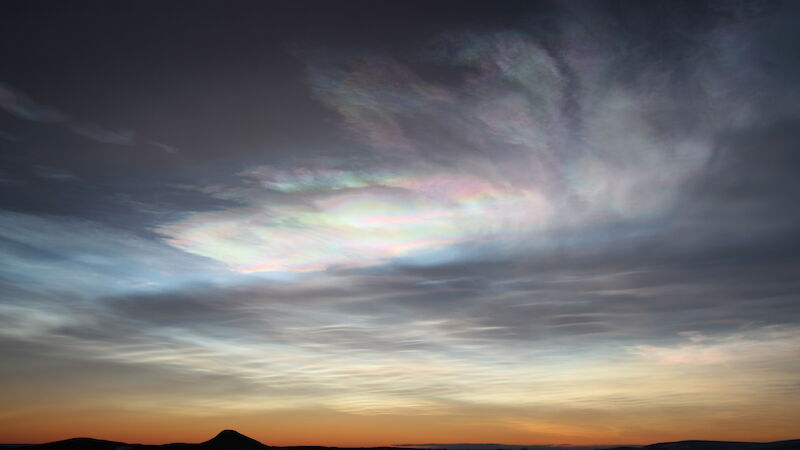The polar stratospheric cloud (PSC) season at the Australian Antarctic continental stations (Mawson, Davis and Casey) typically runs from mid-June to mid-October each year. At the sub-Antarctic sites of Macquarie Island and Heard Island, stratospheric temperatures rarely reach the frost point during winter, but observations are still encouraged.
The best viewing time is when the sun is between about 1 and 6 degrees below the horizon (during civil twilight), when the troposphere is in shadow but the stratosphere is illuminated. This increases the contrast of the PSCs against the background sky, and helps to differentiate against any tropospheric cloud which will appear much darker. The clouds will generally be visible in the twilight arch portion of the sky and you can find out information on the best viewing times for various sites (below). It may also be possible to discern the clouds in strong moonlight.
During the PSC season in Antarctica, the sky is generally covered by a thin yellowish veil of Type I clouds. The veil can be hard to identify, being easily confused with cirrostratus clouds or tropospheric haze. You may notice fine horizontal structures in the veil near the horizon, as well as a bright patch of light a few degrees above the horizon scattered from the sun.
The Type II clouds ('nacreous’ or ‘mother-of-pearl’ clouds) are a less common phenomenon. There is anecdotal evidence that Type II clouds are more prevalent at Mawson compared with the other stations, possibly due to the influence of the nearby mountains. These clouds look distinctly different from tropospheric clouds. They have an overall pearly-white appearance (due to forward-scattering of sunlight), and may also show some delicate interference colours (pinks and greens). A polarising filter may enhance their visibility. Reports of these clouds are the most valuable as they indicate the occurrence of special atmospheric conditions.
The PSCs will generally be travelling in the stratospheric flow, which is predominantly from west to east, and this may help in identification. For example, at Davis the wind direction in the troposphere generally rotates with altitude from north-easterly near the ground, through southerly to be westerly at the tropopause. The motion of the tropospheric clouds may therefore be quite different to the motion of the PSCs. Type II clouds formed by lee-waves may appear at discrete spacings across the sky, and appear quasi-stationary.
PSC viewing information
This page of sunlight and twilight hours provide plots of the times of sunrise, sunset and the limits of civil twilight. The best time to view PSCs is during civil twilight. At Davis, Casey and Mawson, the PSC season runs approximately from mid-June (day 166) to mid-October (day 288). At Davis and Mawson there is a period around mid-winter when the twilight conditions are suitable for continuous cloud observing for a period of several hours.

